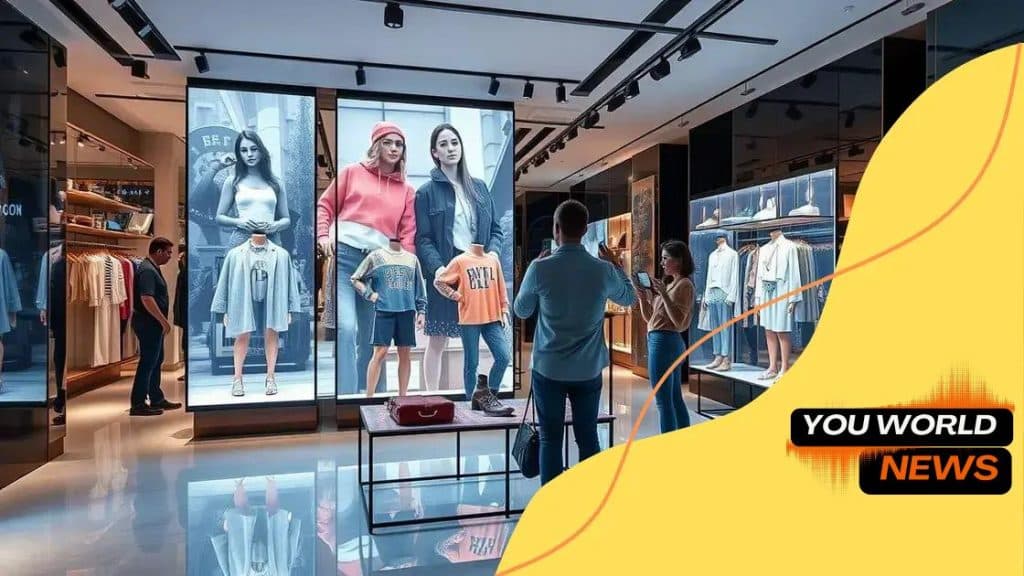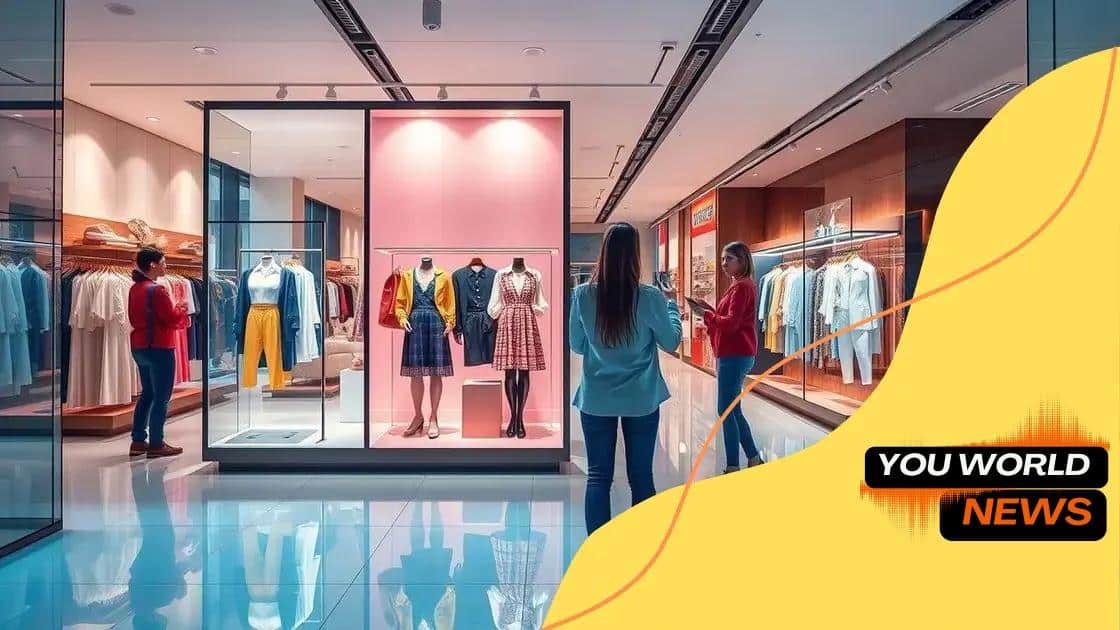Augmented reality in fashion retail experiences opens new doors

Augmented reality in fashion retail enhances the shopping experience by allowing customers to virtually try on clothing, leading to improved engagement, greater purchase confidence, and reduced return rates.
Augmented reality in fashion retail experiences is transforming how we shop, blending digital and physical worlds. Imagine trying on outfits virtually or visualizing how accessories fit into your wardrobe before making a purchase. Curiosities abound in this innovative space.
What is augmented reality in fashion?
Augmented reality in fashion is an innovative technology that blends digital elements with the real world. This exciting approach allows consumers to interact with fashion items in a dynamic way, enhancing their shopping experience.
Imagine walking into a store and being able to try on clothes without stepping into a fitting room. This is augmented reality at work. By using your smartphone or AR glasses, you can see how different outfits look on you, all in real-time. This technology not only captivates shoppers but also helps brands engage their audience uniquely.
How Does AR Work in Fashion?
At its core, augmented reality overlays digital information onto the physical world. When you point your device at an item, the AR system recognizes the product and displays a virtual rendition on your screen. This can include:
- 3D models of clothing or accessories
- Mix-and-match outfit options
- Virtual fitting rooms
- Interactive features that allow customization
This technology is not just about fun; it also addresses practical challenges in shopping, such as uncertainty about fit and style, which can often lead to returns.
Benefits of Augmented Reality in Fashion
The use of augmented reality in fashion offers several advantages:
- Enhanced customer engagement through immersive experiences
- Increased confidence in purchasing decisions
- Reduced return rates due to better fitting visualization
With these benefits, it’s no wonder retailers are investing in AR technology to appeal to a tech-savvy generation. It’s a win-win for both consumers and brands.
Benefits of augmented reality for shoppers
Using augmented reality technology provides shoppers with exciting benefits that enhance their retail experience. This innovation helps consumers make better purchasing decisions and feel more engaged.
One major advantage is the ability to try on products virtually. Instead of guessing how a piece of clothing will look, customers can visualize it on themselves through their devices. This interactive shopping experience reduces uncertainty and enhances satisfaction.
Key Benefits of AR for Shoppers
Here are some key benefits that augmented reality brings to shoppers:
- Improved fitting accuracy, as customers can see how items fit without trying them on physically.
- Increased confidence in purchases, leading to fewer returns.
- Time savings by quickly checking different styles and options.
- Greater engagement with brands through unique and immersive experiences.
Shoppers are more inclined to explore new trends when they can see how pieces fit into their wardrobe seamlessly. Imagine browsing through a collection, selecting a dress, and seeing it on your virtual self in seconds.
The power of augmented reality also allows customers to mix and match outfits, giving them a full view of how different pieces work together. Customers can experience this technology not just in-store but also through apps, making it accessible anytime.
How brands are using AR technology

Brands are increasingly adopting augmented reality technology to enhance customer engagement and streamline their shopping experience. This innovative approach allows companies to stand out in a competitive market by offering unique, interactive experiences.
Many fashion retailers are developing AR applications that let users try on clothes virtually. This means consumers can see how an outfit looks without stepping into a dressing room. This not only appeals to tech-savvy shoppers but also encourages them to explore more products.
Leading Brands Utilizing AR
Several notable brands are harnessing the power of augmented reality:
- IKEA allows customers to visualize furniture in their homes using an AR app, making shopping more intuitive.
- Sephora offers a virtual try-on feature for makeup, so users can test products before buying.
- Adidas integrates AR for customizing shoes, enabling users to see design changes in real-time.
- H&M employs AR in-store displays that activate when viewed through a smartphone, showcasing new styles dynamically.
These examples show how brands are embracing AR technology to enhance the shopping journey and create lasting impressions. By providing interactive options, they not only increase sales but also enhance customer loyalty.
As we move forward, we can expect more brands to explore augmented reality. This technology allows them to connect with consumers in fresh and engaging ways, ultimately transforming the retail landscape.
Real-world examples of AR in retail
Many retailers are successfully incorporating augmented reality into their business models. This technology is transforming how customers interact with products, creating unique and engaging shopping experiences.
For instance, Wayfair, an online furniture retailer, uses AR to help customers visualize how their products will fit in their homes. Users can see a life-sized image of furniture in their space, allowing them to make better choices without any guesswork.
Notable Brands Using AR
Several other brands are effectively utilizing AR technology:
- L’Oreal offers a virtual makeup try-on feature through its app, allowing users to experiment with different looks.
- Nike has launched an AR experience in their app that helps customers find the right shoe size.
- Gucci integrates AR to let users see how shoes will look on their feet using their smartphones.
- Virtual dressing rooms have become common in various brands, enabling consumers to try clothes virtually before purchasing.
By using AR, these retailers not only enhance the shopping experience but also improve customer satisfaction. Customers feel more empowered to make choices that suit them the best, reducing returns and increasing confidence in their purchases.
As we see more real-world examples of AR in retail, it’s clear that this technology is paving the way for a future where shopping is more interactive and personalized.
Future trends of augmented reality in fashion
The future of augmented reality in fashion promises innovative changes that will reshape the shopping experience. Retailers and brands are excited about how this technology can engage customers in new ways.
As we look ahead, one significant trend is the rise of virtual fashion shows. These shows allow brands to showcase their collections in immersive environments accessible globally. Rather than only attending live events, customers can enjoy these shows from their homes, seeing how items move and fit in real-time.
Emerging Trends in AR Fashion
Here are some key trends shaping the future of augmented reality in fashion:
- Personalization: Brands will use AR to offer customized shopping experiences. Customers may create personalized avatars, trying on outfits tailored to their preferences.
- Social Shopping: With AR, social media platforms will integrate shopping features, allowing users to try clothes virtually before sharing their looks with friends.
- Sustainability: AR can reduce waste by allowing customers to make better-informed choices, reducing the number of returns and minimizing the environmental impact.
- Enhanced Customer Service: Retailers will employ AR for providing virtual assistance, guiding customers through their shopping journey with interactive elements.
As these trends develop, the fusion of augmented reality and fashion will create more engaging, efficient, and sustainable shopping experiences. This evolution will lead to a deeper connection between consumers and brands, making shopping more enjoyable and tailored to individual needs.
augmented reality is reshaping the fashion retail experience. This technology not only allows customers to try on clothing virtually but also improves engagement and confidence in purchasing decisions. Brands are embracing this change, offering personalized experiences and interactive features. As we move forward, we can expect exciting developments that will make shopping even more dynamic and enjoyable. It’s an exciting time for both shoppers and retailers as we embrace the future of augmented reality in fashion.
FAQ – Frequently Asked Questions about Augmented Reality in Fashion
What is augmented reality in fashion?
Augmented reality in fashion allows customers to visualize and try on clothing virtually before purchasing, enhancing the shopping experience.
How are brands using augmented reality technology?
Brands use augmented reality to create interactive experiences, allowing customers to see how products look and fit in real-time.
What are the benefits of using augmented reality in shopping?
Benefits include increased customer engagement, better fitting accuracy, and reduced return rates, leading to improved customer satisfaction.
What future trends can we expect in augmented reality for fashion?
Upcoming trends include virtual fashion shows, personalized shopping experiences, and enhanced customer service through interactive elements.





